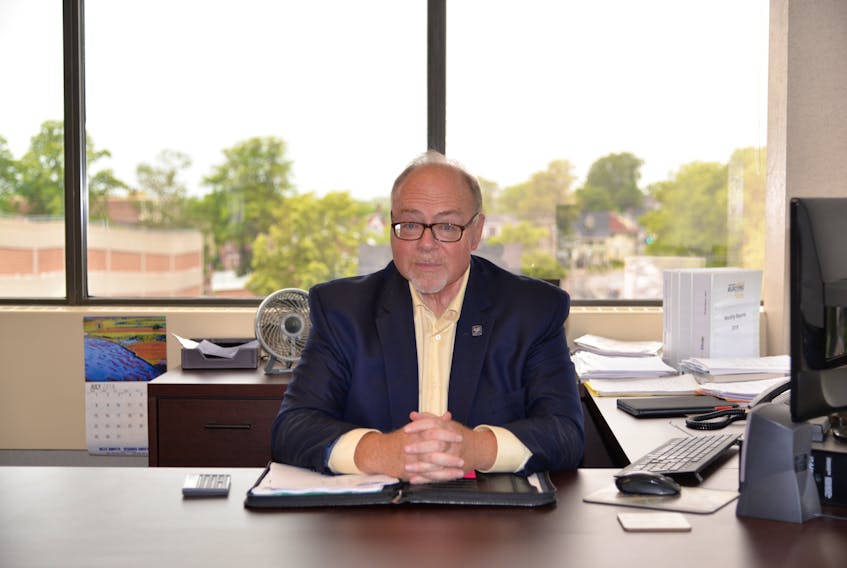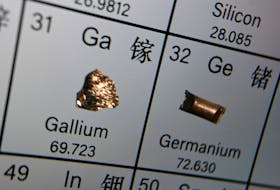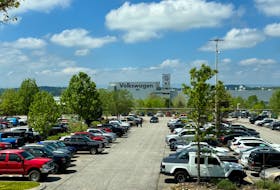John Gaudet didn’t have to travel far from the Charlottetown home near Rochford Square
Where he grew up to the top floor of the Maritime Electric building on Kent Street.
“I was one of the lucky ones that got a job in my home town,” said Gaudet, president and CEO of Maritime Electric Company Limited.
Gaudet has been with the company for 37 years. He graduated from UPEI with a diploma in engineering and then graduated from the former Technical University of Nova Scotia (TUNS) in Halifax with a bachelor of electrical engineering. In 1981, Gaudet began his career with the power company as an engineer in training.
Maritime Electric is owned by the Newfoundland and Labrador-based Fortis Inc.
In 2017, Maritime Electric had 80,000 customers and 185 employees.
These are interesting times for the power company. As the province’s population increases, so too is the demand for power, and in particular, electric heat. Other issues the power company is planning for include the anticipated increased popularity of electric cars and the potential implementation of a carbon tax.
The company is also nearing the end of a three-year, 2.3-per-cent annual rate increases. In March, customers will see new rates that Gaudet says will continue to be stable along with “inflationary level increases.”
Since Gaudet took over the top job on April 1, 2016, he said it’s been a rewarding experience to plan for those challenges and continuously work on improving the company.
When asked what the company is doing right, Gaudet doesn’t hesitate to point out the hard work and dedication of employees, especially during storm-related power outages and the occasions they’re asked to go out of province to help others.
Gaudet recently sat down with The Guardian for a Q&A to discuss the company and supplying energy to Islanders.
Q: Maritime Electric is coming to the end of a three-year, 2.3 per cent annual rate increase. What can customers expect to see with new rates in March?
A: We're committed to continue on with rate stability. We've heard loud and clear from our customers that their experience was not acceptable prior to the energy accord, which took effect in 2011. We've been able to stabilize rates since then with inflationary level increases. So, that's what we're working hard on to replicate for the future. Our objective is to continue inflationary level rate increases into the future.
Q: What is Maritime Electric doing to prepare to supply electricity for electric cars as they become more popular on the Island?
A: We don’t see that in the immediate future, but we need to be ready for it. Because when we rebuild a line this year, we want it to be serviceable for future usage and the electricity of transportation. So, we are overbuilding some facilities for that reason. And, we will be in a position to provide that fuel when it comes. A lot of people who are following the file, and have activity in file, are saying it’s going to be mid-next decade before this starts to ramp up.
But, we need to act differently today because we're going to rebuild the lines, say for example in front of your house, once every 40 years. We don't want to rebuild it today, and then in 15 years, have to rebuild it. So that's a balancing act. And, that cost money and that puts pressure on rates. So, we're trying to find a balance. In addition to finding that balance, there are other purposes these larger lines can serve, and that is rerouting and reconfiguring our lines to improve reliability.
“P.E.I. is blessed with a very strong wind regime, and the wind farms that are here perform very well. But using that wind power on P.E.I. and having it backstopped by somebody else for when the wind doesn't blow, those are the real challenge to address and overcome.”
Q: Wind energy makes up 25 per cent of the province’s energy supply. What is the potential of wind energy and the challenges associated with it?
We've been talking with the province, and we think we can easily incorporate another 30-megawatt wind farm into the P.E.I. system over the next couple of years. And, they're working on that. The issue with wind is its intermittency and the need to have somebody to back stop it. There's a cost associated with that. And, that cost makes it less economical to purchase, or to develop wind. You have to move your wind energy supply growth as your system load grows such that you're not incurring back stopping costs against it. So, we see wind growing on P.E.I. probably by five to 10 per cent increments over the next 20 years. But it needs to be carefully and thoughtfully studied, and we need to look at the impacts on our energy purchases and the need to have it back stopped. That’s where we're at today. And we believe that all can be accommodated for another 30-megawatt wind farm in the next two to three years. And then it may be another three to five years after that, another 30-megawatt wind farm. There are technical challenges, financial challenges associated with it. P.E.I. is blessed with a very strong wind regime, and the wind farms that are here perform very well. But using that wind power on P.E.I. and having it backstopped by somebody else for when the wind doesn't blow, those are the real challenge to address and overcome.
Q: What impact will a carbon tax have on Maritime Electric and its customers?
From an energy supply perspective, 25 per cent of our supply is from on-Island wind, which there's no carbon associated with that. We have another 15 per cent from New Brunswick power – the Point LePreau generating station. And there's no carbon with that. So, the balance of supply, which is to 60 per cent, we buy as it system energy from New Brunswick. And we just renewed a contract for five years. But what we've done in the contract renewal is we have mitigated price increases due to carbon from New Brunswick as the source. So, we've got our prices set for the next five years that have mitigated impacts from New Brunswick due to a change in price or the increased price of carbon. So, there's very little impact of carbon tax on Maritime Electric or its customers from its energy supply perspective. But we are roughly a good size company on P.E.I., and we use a lot of fuel ourselves. But it's in the hundreds of thousands of dollars on our grand scheme. We spend about $200 million a year in our business, and we see carbon tax affecting our operations through increased cost of goods and services. And, the fuel we use of being a small percentage of that, so we don't think it is initially material. And, we really don't know how the impact of a carbon tax will be felt as it moves through the economy. Right from the refinery to our fleet fuel to our end use. But scale wise, it's not a large component of our operating cost and so we don't believe it to be material.
Q: What are some of the things Maritime Electric is doing to mitigate the impact of storms in relation power outages?
We found that areas are served by a single source. And by duplicating or building new facilities to serve new customers and increase the capacity to an area, you can also provide a second source to that community or area. We're looking at that. Or, putting in more distribution points. In 2018, we have a new substation underway in the Mount Albion area, which provides another distribution point, obviously in that area. But it gives us the capability, when we need to, connect the wires from the new substation to an existing substation and back feed. So, we can manipulate the grid to improve reliability. And, that's what we're going to be doing. We've got initiatives planned along those lines. The other is just storm hardening our system. Putting in bigger, stronger and taller poles and bigger wires closer together. We've been doing that and will continue to do that.









